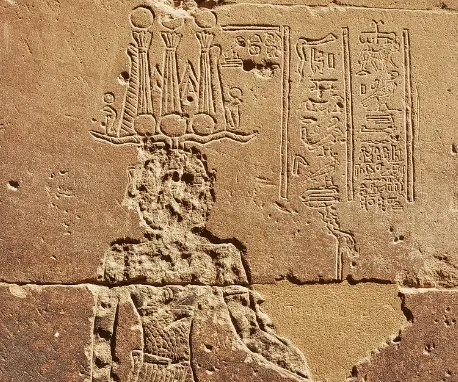
Hieroglyphs, meaning “sacred carvings (or words)” in Greek, were in use in ancient Egypt for around four thousand years from 3,200 BC to 394 AD, which is the date that the Graffito of Esmet-Akhom was carved. It was the last known ancient Egyptian inscription written in Egyptian hieroglyphs. But why did hieroglyphs cease to be used?
The last use of hieroglyphs in ancient Egypt
The Graffito of Esmet-Akhom was carved in the temple of Philae in southern Egypt on August 24 394 AD, hence the inscription’s other name, Philae 436. It was created by a priest named Nesmeterakhem (or Esmet-Akhom) and comprises text wherein Nesmeterakhem records his hope that his inscription will last “for all time and eternity,” etched alongside the figure of the god Mandulis.
The inscription also contains a text in the demotic script with more or less the same content.
The temple at Philae represented a significant site of worship for the ancient Egyptians and their religion, as it was believed to be one of the burial places of the god Osiris. The main god worshipped, however, was Isis, the sister-wife of Osiris. However, many other gods are known to have been worshipped at the temple, such as Hathor, Imhotep, Khnum, and Nephthys.
A handful of gods originating in Nubia in the south—which included Mandulis—were also the subjects of worship for the ancient Egyptians that visited the temple.
The Graffito of Esmet-Akhom is comprised of two inscriptions, one etched in Egyptian hieroglyphs and another written in the Egyptian demotic script. The texts are separated into two parts by the carved figure of the god Mandulis.
What does the graffito say?
In English, the hieroglyph inscription reads: “Before Mandulis, son of Horus, by the hand of Nesmeterakhem, son of Nesmeter, the Second Priest of Isis, for all time and eternity. Words spoken by Mandulis, lord of the Abaton, great god.”
The demotic script translates to “I, Nesmeterakhem, the Scribe of the House of Writings of Isis, son of Nesmeterpanakhet the Second Priest of Isis, and his mother Eseweret, I performed work on this figure of Mandulis for all time, because he is fair of face towards me. Today, the Birthday of Osiris, his dedication feast, year 110.”
Both texts were carved on a gateway that was added to the temple by Roman Emperor Hadrian. This feature led directly towards the Abaton, the sanctuary which ancient Egyptians believed housed the tomb of Osiris’s remains.
Nesmeterakhem belonged to a family of priests who ran the temple, and because of the Christianization of Egypt, it is plausible that belief in the old Egyptian gods by Nesmeterakhem’s era did not extend much further than his immediate family. Not long after the 394 AD graffito was created, it is probable that there was no longer anyone alive who could read the hieroglyphs.
What happened to the temples of ancient Egypt?
The hieroglyph inscription created by Nesmeterakhem is from the period after the pagan temples of ancient Egypt were shut down by Roman Emperor Theodosius I in 391 or 392 AD. The Philae temple survived the closures because it was situated just outside the borders of the Roman Empire.

In Theodosius’s edict, which saw the shutting down of temples in ancient Egypt, he also saw to it that the use of hieroglyphs in monumental inscriptions was brought to an end.
Later texts have been discovered at Philae. However, they were written in either demotic or Greek. The Philae temple, apparently continually staffed by members of Nesmeterakhem’s family, was finally closed down on the orders of Emperor Justinian I between 535 and 537 AD.
The date inscribed in the demotic text, the “Birthday of Osiris” in “year 110,” lines up with August 24 394 AD in the Gregorian calendar. This was forty years after the penultimate known hieroglyphic inscription.
Throughout Egyptian history, hieroglyphs were always closely associated with high-society and religious display, which makes it particularly fitting that the last known example of them is in connection with the figure of a deity.
In ancient Egypt, “non-standard” hieroglyphs were occasionally used as an early form of cryptography—not so much as an attempt at secret communication but rather in religious contexts to serve as a warning to readers that they were dealing with the dangerous realms of the gods. Nesmeterakhem was seemingly familiar with Egyptian cryptography, evidenced by the fact that the hieroglyphic inscription contains an uncommon sign substitution.
When writing the first section of his father Nesmeterpanakhet’s name in hieroglyphs, the priest spelled it ns-mtr, using the Hedjet (white crown) symbol for the ns portion. This was only used to represent ns or nsw.t in cryptography.
Thus, ancient Egyptian hieroglyphs ceased to be used primarily because of the orders of Roman Emperor Theodosius I, who sought to have them banned from any and all monuments and systematically closed down all the temples of ancient Egypt.
See all the latest news from Greece and the world at Greekreporter.com. Contact our newsroom to report an update or send your story, photos and videos. Follow GR on Google News and subscribe here to our daily email!



